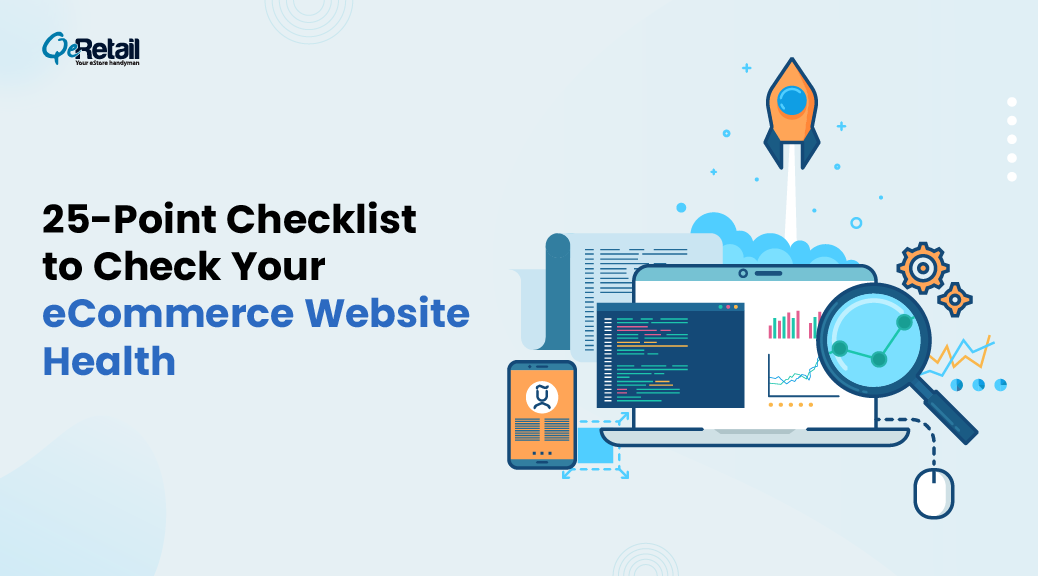With online holiday sales reaching a whopping $207 billion in 2022 alone, the holiday season presents a massive opportunity for eStore owners. To help you seize this potential, we’ve crafted a 25-point checklist designed to skyrocket your sales and create an exceptional shopping experience.
Covering everything from website design to marketing strategies and customer service, our actionable checklist will equip you with the tools to outshine the competition and make this holiday season your most profitable yet. Don’t let the holiday rush catch you off guard—get ready to sleigh the season with your eStore!
Prepare your eStore for success and make this holiday season unforgettable for your customers and your bottom line. Let’s dive into our comprehensive checklist and get ready to boost sales and delight customers this holiday season!
Table of Contents
The 25-Point Checklist to Check Your eStore’s Health
#1. Website Design and Functionality
#2. Product Catalog
#3. Checkout Experience
#4. Customer Service and Support
#5. Performance and Speed
#6. Search Engine Optimization (SEO)
#7. Marketing and Promotion
#8. Analytics and Tracking
#9. Security and Privacy
#10. Inventory Management
#11. Shipping and Fulfillment
#12. Customer Feedback and Satisfaction
#13. Competitor Analysis
#14. Website Maintenance
#15. Stay Informed
#16. Mobile Optimization
#17. Social Proof
#18. A/B Testing
#19. Cross-Selling and Upselling
#20. Content Marketing
#21. Email List Building
#22. Personalization
#23. Affiliate Marketing
#24. Social Media Advertising
#25. Conversion Rate Optimization
Website Design and Functionality:
A visually appealing and user-friendly website is crucial for a positive user experience. In fact, 75% of consumers judge a company’s credibility based on its website design. So, a visually appealing website not only creates a positive first impression but also contributes to increased user engagement
Tools: Check your website’s design and responsiveness using tools like Google PageSpeed Insights or GTmetrix.
Improvements:
- Optimize website layout for better visual appeal and intuitive navigation.
- Ensure seamless functionality across different devices and screen sizes.
- Conduct user testing to identify and fix any usability issues.
Product Catalog:
Optimizing your product catalog is key to helping customers find and understand your offerings. According to studies, 76% of online shoppers prioritize detailed product descriptions.
Tools: Review your product catalog organization and information using spreadsheet tools like Google Sheets or Microsoft Excel.
Improvements:
- Categorize products logically to aid navigation.
- Enhance product descriptions with relevant details and benefits.
- Use high-quality images to showcase products effectively.
Checkout Experience:
Revamp your checkout experience to eliminate cart abandonment. With an average online shopping cart abandonment rate of around 69.99% (Baymard Institute), it’s time to take action and optimize your checkout process for higher conversions.
Tools: Test your checkout process using tools like Google Analytics or Hotjar to analyze user behavior and identify any bottlenecks.
Improvements:
- Simplify the steps required to complete a purchase.
- Clearly display shipping options, costs, and delivery time estimates.
- Integrate a trusted payment gateway for secure transactions.
Customer Service and Support:
Exceptional customer service fosters trust and loyalty, with 96% of customers considering their experience when deciding on loyalty. Prioritizing excellent customer service cultivates lasting relationships and boosts customer satisfaction.
Tools: Implement a help desk solution like Freshdesk or Zendesk for efficient customer support management.
Improvements:
- Ensure accurate and easily accessible contact information.
- Respond promptly to customer inquiries and provide helpful solutions.
- Regularly update and expand your FAQ section to address common queries.
Performance and Speed:
Fast-loading websites enhance user experience and improve search engine rankings. Research shows that 47% of consumers expect a web page to load in 2 seconds or less, and 40% will abandon a website that takes more than 3 seconds to load.
Tools: Measure your website’s performance using tools like Google PageSpeed Insights or Pingdom.
Improvements:
- Optimize image sizes and enable compression for faster loading times.
- Minimize HTTP requests and leverage browser caching.
- Consider upgrading your hosting plan or using a content delivery network (CDN) for improved speed.
Search Engine Optimization (SEO):
Businesses that prioritize SEO enjoy a staggering 14.6% average conversion rate. By optimizing your website for search engines, you can increase visibility and attract organic traffic, paving the way for greater success online.
Tools: Utilize free SEO tools like Google Search Console or Moz’s Keyword Explorer for keyword research and performance tracking.
Improvements:
- Conduct keyword research and incorporate relevant keywords into your content.
- Optimize meta tags, titles, and headings to improve search engine rankings.
- Generate high-quality backlinks from reputable websites to boost SEO.
Marketing and Promotion:
Effective marketing strategies have a direct impact on driving traffic and increasing conversions. Through strategic tactics and targeted campaigns, businesses can achieve significant results.
Tools: Utilize social media management tools like Hootsuite or Buffer for efficient social media marketing.
Improvements:
- Leverage social media platforms to promote your products and engage with your target audience.
- Implement email marketing campaigns to nurture customer relationships and drive repeat business.
- Consider running targeted online advertising campaigns to expand your reach.
Analytics and Tracking:
Monitoring website analytics provides insights for data-driven decision-making. HubSpot’s study revealed that companies that prioritize blogging are 13 times more likely to see a positive return on investment (ROI). Boost your results with valuable content.
Tools: Set up Google Analytics or similar tools to track website metrics and user behavior.
Improvements:
- Regularly review analytics reports to understand user demographics, traffic sources, and conversion rates.
- Set specific goals and track key performance indicators (KPIs) to measure your website’s success.
- Identify areas for improvement based on data and make informed optimizations.
Security and Privacy:
In a survey by the Pew Research Center, a striking 91% of Americans expressed concerns about their loss of control over the collection and use of their personal information by companies. To establish trust, it is vital for businesses to prioritize the security and privacy of customer data, ensuring that their information is handled responsibly and transparently.
Tools: Implement SSL certificates using tools like Let’s Encrypt to secure your website.
Improvements:
- Clearly communicate your privacy policy and explain how customer data is handled.
- Regularly update and patch software and plugins to prevent vulnerabilities.
- Comply with data protection regulations such as GDPR or CCPA.
Inventory Management:
74% of US consumers expressed frustration when desired items were unavailable, as per a study by Statista. Efficient inventory management is crucial to prevent stockouts and enhance customer satisfaction by ensuring products are readily available.
Tools: Utilize inventory management tools like Zoho Inventory or TradeGecko for better control and tracking.
Improvements:
- Implement an inventory tracking system to monitor stock levels and reorder products in a timely manner.
- Conduct regular audits to ensure accuracy and identify any discrepancies.
- Optimize inventory turnover by analyzing sales data and identifying slow-moving items.
Shipping and Fulfillment:
84% of customers attribute their overall perception of a brand to the shipping and delivery experience, as revealed by a Salesforce survey. A seamless shipping and delivery process plays a pivotal role in creating a positive customer experience, emphasizing the significance of efficient logistics operations for building strong brand impressions.
Tools: Use shipping management tools like ShipStation or Shippo for streamlined order fulfillment.
Improvements:
- Partner with reliable shipping carriers to ensure timely and cost-effective delivery.
- Clearly communicate shipping policies, rates, and estimated delivery times to customers.
- Regularly review and optimize your shipping processes to minimize errors and delays.
Customer Feedback and Satisfaction:
Actively listening to customers and addressing their feedback helps improve your products and services. According to a study by Qualtrics, 77% of customers view companies more favorably if they seek out and act upon customer feedback.
Tools: Set up customer feedback and survey tools like SurveyMonkey or Typeform to gather valuable insights.
Improvements:
- Encourage customers to provide feedback through various channels and actively seek their opinions.
- Respond to customer reviews and comments promptly, addressing concerns and demonstrating care.
- Continuously improve your products and services based on customer feedback and preferences.
Competitor Analysis:
Competitor analysis is essential for staying competitive and improving your business. It helps you understand your competitors’ strategies, identify market gaps, improve product development, adjust pricing and promotions, enhance marketing strategies, and stay updated with industry trends.
Tools: Conduct competitor analysis using tools like SEMrush or SimilarWeb for insights into competitors’ performance.
Improvements:
- Monitor your competitors’ pricing, promotions, and product offerings to stay competitive.
- Analyze their marketing strategies and identify opportunities for differentiation.
- Incorporate successful tactics from your competitors into your own marketing efforts.
Website Maintenance:
Regular website maintenance ensures optimal performance and a smooth user experience. A report by Google reveals that 53% of mobile users abandon websites that take more than three seconds to load.
Tools: Use website monitoring tools like UptimeRobot or StatusCake to check your website’s uptime and receive notifications.
Improvements:
- Regularly update and patch your website’s software, plugins, and themes to maintain security and functionality.
- Perform regular backups to safeguard against data loss.
- Test your website’s functionality across different browsers and devices to ensure compatibility.
Stay Informed:
To stay ahead of the competition and stay informed about industry trends and innovations. Adapt and evolve your strategies based on this knowledge for continued success.
Tools: Subscribe to industry newsletters, and blogs, and follow relevant social media accounts for updates.
Improvements:
- Attend webinars, conferences, or networking events to learn from industry experts and expand your knowledge.
- Stay informed about emerging technologies and trends that can benefit your eStore.
- Continuously adapt and evolve your strategies based on new insights and market developments.
Mobile Optimization:
With 88% of consumers being less likely to return to a website that provides a poor mobile experience, prioritizing website optimization for mobile devices is crucial due to the increasing number of mobile users.
Tools: Use tools like Google’s Mobile-Friendly Test or BrowserStack for mobile compatibility testing.
Improvements:
- Optimize the layout and design for smaller screens.
- Ensure buttons and links are easily tappable on mobile devices.
- Improve page load speed on mobile devices.
Social Proof:
Build trust and credibility by leveraging social proof. Nielsen’s study shows that 92% of consumers trust recommendations from friends, family, and online reviews more than traditional advertising.
Tools: Utilize social proof tools like Trustpilot or Yotpo for collecting and displaying customer reviews.
Improvements:
- Encourage satisfied customers to leave reviews and testimonials.
- Display positive reviews prominently on your website.
- Leverage user-generated content, such as customer photos and testimonials.
A/B Testing:
Maximize your website’s potential with A/B Testing. Test variations to find the winning design and content. Make data-driven decisions, optimize user experience, and boost engagement and conversion rates.
Tools: Use A/B testing tools like Google Optimize or Optimizely to run experiments.
Improvements:
- Test different headlines, product descriptions, or call-to-action buttons to improve conversions.
- Experiment with different layouts or color schemes to optimize user engagement.
- Analyze test results and implement changes based on data-driven insights.
Cross-Selling and Upselling:
By implementing upselling and cross-selling techniques, businesses can significantly boost their revenue. Research conducted by Harvard Business School reveals that such strategies can lead to an impressive average revenue increase ranging from 10% to 30%.
Tools: Utilize cross-selling and upselling features in your e-commerce platform or use plugins like WooCommerce Product Recommendations.
Improvements:
- Recommend related or complementary products on product pages.
- Offer bundles or discounts for purchasing multiple items together.
- Highlight premium or upgraded options during the checkout process.
Content Marketing:
Creating and sharing valuable content to attract and engage your target audience can result in conversion rates six times higher than those without content marketing.
Tools: Use content creation tools like Canva or Grammarly to create visually appealing and error-free content.
Improvements:
- Develop a content strategy that aligns with your target audience’s interests and pain points.
- Create blog posts, videos, or infographics that provide educational or entertaining content.
- Promote your content through social media, email newsletters, or guest posting on relevant websites.
Email List Building:
Build an email list to nurture relationships and drive repeat business, as email marketing boasts an average ROI of $42 for every $1 spent (DMA).
Tools: Utilize email marketing tools like Mailchimp or ConvertKit for list building and campaign management.
Improvements:
- Offer incentives such as discounts or exclusive content to encourage visitors to sign up for your email list.
- Use opt-in forms strategically throughout your website.
- Segment your email list to send targeted and personalized campaigns.
Personalization:
Personalize customer experiences to enhance engagement and satisfaction—80% of consumers are more likely to make a purchase when brands offer personalization (Epsilon).
Tools: Utilize personalization tools like OptinMonster or Monetate for tailoring content and offers.
Improvements:
- Use customer data and browsing behavior to offer personalized product recommendations.
- Address customers by name in emails or personalized messages.
- Implement dynamic content that adapts to the preferences and interests of individual users.
Affiliate Marketing:
To expand your reach and drive sales, it is recommended to leverage affiliate marketing. This is supported by a study conducted by Rakuten Marketing, which found that 81% of brands reported increased customer acquisition and sales through their affiliate programs.
Tools: Utilize affiliate marketing platforms like ShareASale or Commission Junction to manage affiliate programs.
Improvements:
- Set up an affiliate program and recruit affiliates who align with your target audience.
- Provide affiliates with promotional materials and unique tracking links.
- Regularly analyze affiliate performance and provide incentives for top performers.
Social Media Advertising:
Utilize targeted social media advertising to expand your reach, as 73% of marketers find it effective in increasing brand exposure and reach.
Tools: Use social media advertising platforms like Facebook Ads Manager or Twitter Ads for campaign management.
Improvements:
- Define your target audience and select appropriate demographics and interests for your ads.
- Create compelling ad copy and visuals that grab attention.
- Monitor ad performance and make adjustments based on data and audience response.
Conversion Rate Optimization:
Continuously optimize your website to improve conversion rates, considering that businesses spend $92 on acquiring website traffic for every $1 invested in conversion rate optimization (CRO) (Econsultancy).
Tools: Utilize conversion rate optimization tools like Crazy Egg or Hotjar for heatmaps and user behavior analysis.
Improvements:
- Analyze user behavior and identify potential bottlenecks or areas for improvement in the conversion funnel.
- Test different variations of landing pages, forms, or calls to action to optimize conversion rates.
- Simplify the checkout process and reduce friction points.
Conclusion:
Optimize your eCommerce website for success by regularly evaluating and improving its performance, SEO rankings, user experience, and engagement. Follow our comprehensive guide to enhance your online presence and drive sales. For expert assistance, connect with QeRetail to unlock a range of services tailored to your eStore’s needs. Thrive in the competitive eCommerce landscape with their support and watch your business flourish.







